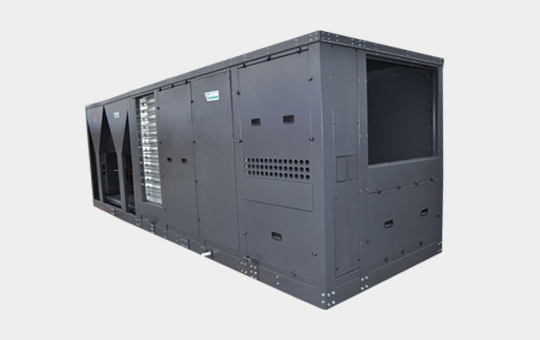Roof top air conditioners are manufactured compactly. The body structure of the device is formed with a steel frame system with increased strength with special bending techniques. Galvanized sheets with a thickness of 1.2 to 2.0 mm are used according to the width of the surface area. The sheets used are coated with electrostatic paint as well as being galvanized. There is a 3 mm thick special type chassis part under the roof top air conditioner. There are eyebolt parts for tying ropes and special sections for lifting with forklifts on the chassis. Condenser fans are used with external rotor axial blades. Scroll compressors are used independently in 2, 3 or 4 circuit cooling system. Condenser and evaporator coils are manufactured with copper pipes and aluminum fins. Blowing fans are used with radial dense blades or radial rare blades. Environmentally friendly R407c and R410a gases are used in roof top air conditioners.
Roof top air conditioners are equipped with a very sensitive and functional automation system. All operating and fault status information of the device can be followed on the digital screen.
Rooftop air conditioners, also known as rooftop package air conditioners, are devices used in multi-functional air conditioning systems. They are units that have ventilation and air conditioning feature at the same time. Roof top air conditioners are used in projects that require fresh air and exhaust, and offer flexible solutions by performing both heating, cooling and ventilation at the same time. The cities we live in are places where there are no architectural designs where we can reach fresh air immediately when we open the window. Buildings that are completely isolated from the external environment have made ventilation systems compulsory. Rooftop air conditioning systems, which are installed on the terrace floors of the buildings or in the installation rooms created in the intermediate floors, solve all needs from a single point. Rooftop manufacturing is made in many different configurations. Thanks to the enthalpy control, the more fresh air is needed, the more fresh air is supplied, which saves energy. In models with economizer, comfort conditions are provided by cooling in line with the need. Thanks to the free coling system, the cold air in the outdoor environment is sent directly to the inside and cooling is performed at very low costs. In heat recovery models, on the other hand, dirty air exhaust is made from the environment and fresh air is sent to the indoor environment. Roof top air conditioners also differ according to the climatic conditions to be used. Only cold models are used in hot climatic conditions. In the middle zone where 4 seasons are experienced, heat pump system devices are used. In colder regions, natural gas heated and water coil heated devices are used. Since roof top air conditioners have a wide range of models, they are used as air conditioning and ventilation equipment in all kinds of projects.
Rooftop package air conditioners are very special devices preferred in all kinds of projects. Roof top air conditioner prices provide more advantages than other alternative systems. Roof top air conditioners are manufactured in different capacities from 9 to 300 kW and are used for air conditioning of areas of different volumes. The fact that it ventilates especially while air conditioning ensures that it meets all hvac needs. Roof top air conditioning systems are especially preferred in large shopping center projects. It is used in the air conditioning of the shops in the shopping center as well as the foyer areas. An equal amount of air is sent to the entrance of each shop by leaving a volimetric air damper on the air duct. It is used in cinema and theater halls. It allows the polluted air caused by the human density inside to be expelled without energy loss. It provides a much more beautiful and fresh environment by making both fresh air, exhaust and heating-cooling functions at the same time. It provides economic and functional air conditioning in hospitals and large-scale private sector and public buildings. Small capacity models are used for air conditioning of residential offices and smaller areas. The fact that the air flow and pressure can be adjusted in roof top air conditioners can be used in projects with different pressure losses. By using scroll compressors in independent circuits, capacity control can be performed in 4 different steps as 25% 50% 75% 100%. Capacity control is made according to the average value of the information received from the return air and sensor elements on the space.
Roof top air conditioning systems are more advantageous than other alternative systems because they contain all hvac functions. While alternative air conditioning systems perform their heating, cooling and ventilation functions by means of separate devices, these features coexist in the roof top air conditioner. In order for the air handling unit and ventilation systems to work fully efficiently, they must be controlled by an automation system. However, integrated automation systems are ready for roof top air conditioners. Electronic control systems of the devices can communicate with BMS systems in accordance with international automation protocols. Roof top air conditioners can provide fast and effective air conditioning with DX direct expansion cooling systems. The calorie transfer is done directly by the compressor itself. Due to the absence of different elements such as piping and pumps in the system, there is no efficiency loss.

